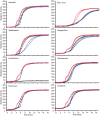Clinically relevant mutant DNA gyrase alters supercoiling, changes the transcriptome, and confers multidrug resistance
- PMID: 23882012
- PMCID: PMC3735185
- DOI: 10.1128/mBio.00273-13
Clinically relevant mutant DNA gyrase alters supercoiling, changes the transcriptome, and confers multidrug resistance
Abstract
Bacterial DNA is maintained in a supercoiled state controlled by the action of topoisomerases. Alterations in supercoiling affect fundamental cellular processes, including transcription. Here, we show that substitution at position 87 of GyrA of Salmonella influences sensitivity to antibiotics, including nonquinolone drugs, alters global supercoiling, and results in an altered transcriptome with increased expression of stress response pathways. Decreased susceptibility to multiple antibiotics seen with a GyrA Asp87Gly mutant was not a result of increased efflux activity or reduced reactive-oxygen production. These data show that a frequently observed and clinically relevant substitution within GyrA results in altered expression of numerous genes, including those important in bacterial survival of stress, suggesting that GyrA mutants may have a selective advantage under specific conditions. Our findings help contextualize the high rate of quinolone resistance in pathogenic strains of bacteria and may partly explain why such mutant strains are evolutionarily successful.
Importance: Fluoroquinolones are a powerful group of antibiotics that target bacterial enzymes involved in helping bacteria maintain the conformation of their chromosome. Mutations in the target enzymes allow bacteria to become resistant to these antibiotics, and fluoroquinolone resistance is common. We show here that these mutations also provide protection against a broad range of other antimicrobials by triggering a defensive stress response in the cell. This work suggests that fluoroquinolone resistance mutations may be beneficial under a range of conditions.
Figures




References
-
- Worcel A, Burgi E. 1972. On the structure of the folded chromosome of Escherichia coli. J. Mol. Biol. 71:127–147. - PubMed
-
- Cameron AD, Stoebel DM, Dorman CJ. 2011. DNA supercoiling is differentially regulated by environmental factors and FIS in Escherichia coli and Salmonella enterica. Mol. Microbiol. 80:85–101. - PubMed
-
- Drlica K. 1990. Bacterial topoisomerases and the control of DNA supercoiling. Trends Genet. 6:433–437. - PubMed
Publication types
MeSH terms
Substances
Grants and funding
LinkOut - more resources
Full Text Sources
Other Literature Sources
